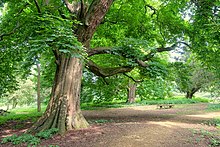Lamport, Buckinghamshire
52°01′44″N 0°59′49″W / 52.029°N 0.997°W

Lamport (occasionally also Langport) was a hamlet in the parish of Stowe in north Buckinghamshire, England. It was cleared by the Temple family, as a result of enclosures, after 1739, to improve the amenity value of their new park at Stowe.[1] The hamlet's name is Old English, meaning long town.[2]
History[edit]
Lamport consisted of two ancient manors, one of which was owned by the priory of Oseney and passed to Stowe; the other seems to have belonged to Luffield Abbey, whose estate had passed, by 1350, to a family named after the hamlet, and subsequently passed by marriage, in 1416, to the Dayrells (whose name continues in the village name of Lillingstone Dayrell).[2] It was annexed to Stowe to provide homes for the staff and servants of the new manor house there[citation needed].
In 1637, Peter Temple enclosed land around Lamport for his deer park. This aggrieved the Dayrells, who owned some of the enclosed land. A dispute, occasionally violent, ensued and eventually led to litigation in 1640 and a petition to Parliament. Notwithstanding the Dayrells' resistance, the village's continued to be enclosed and it was abandoned sometime after 1739.[1]
References[edit]
- ^ a b Fisk, Stephen (June 2009). "Abandoned Communities - Stowe". Retrieved 21 July 2009.
- ^ a b Quick, Kevin (1 October 2005). "Stowe (including Boycott, Dadford and Lamport)". UK & Ireland Genealogy. Archived from the original on 24 August 2009. Retrieved 21 July 2009.

